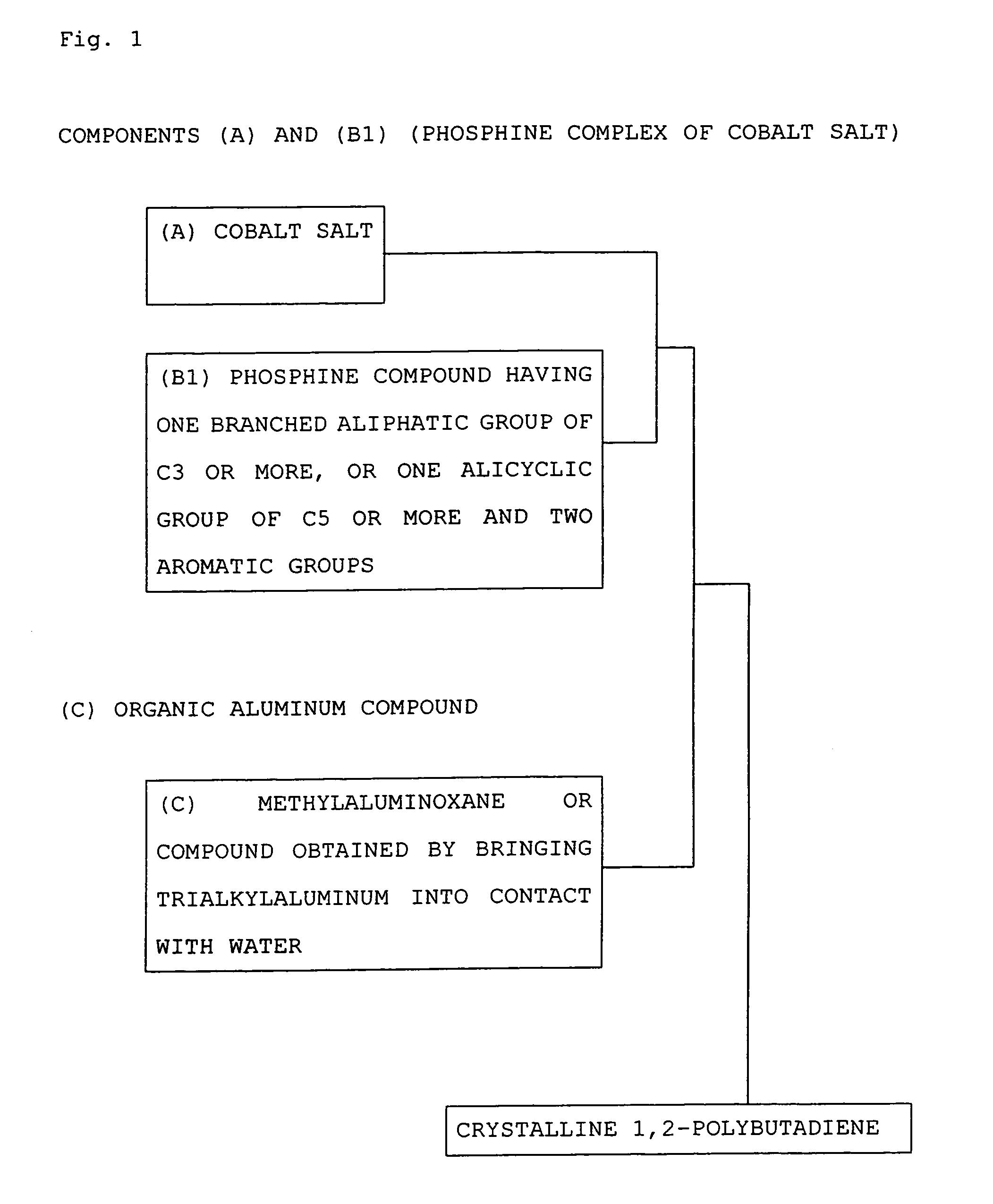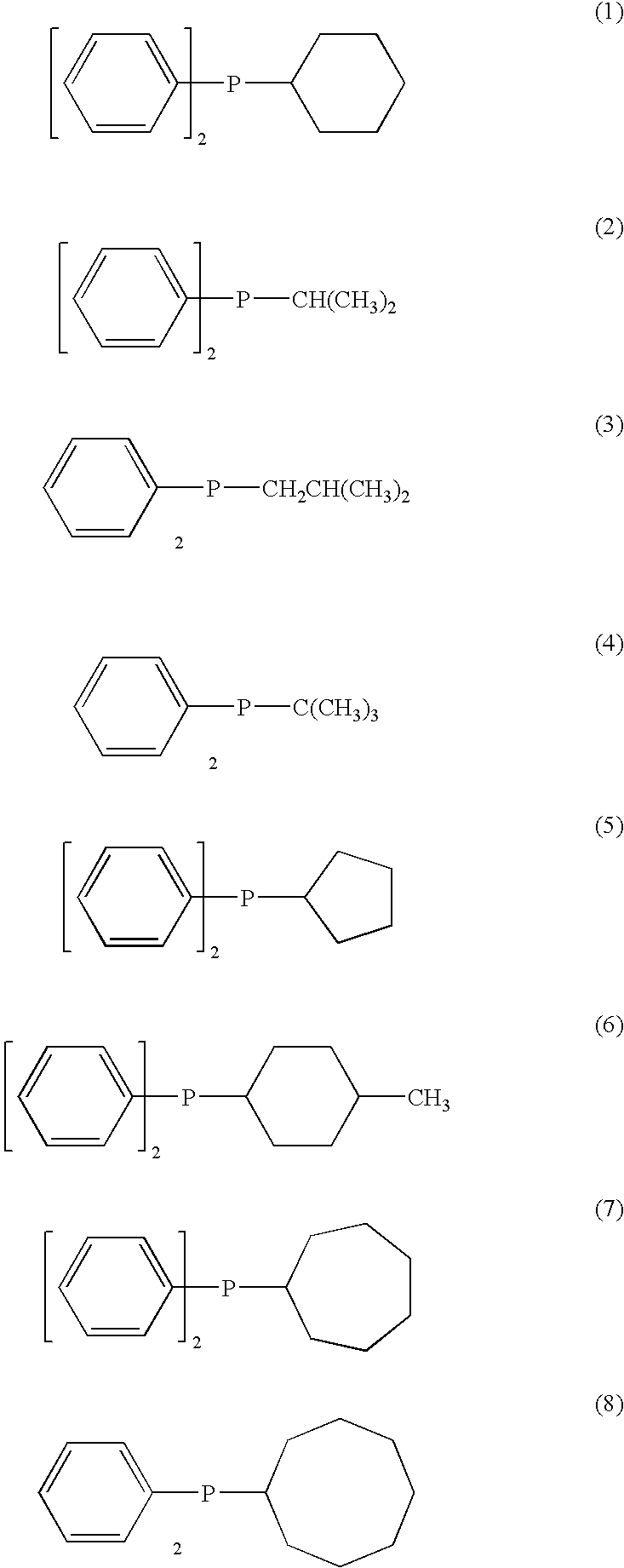Process for producing crystalline 1,2-polybutadiene
a technology of polybutadiene and crystalline form, which is applied in the field of process for producing crystalline form, can solve the problems of increasing the amount of solvent, increasing energy loss, and large equipment for preparing catalyst components, and requiring excessive investmen
- Summary
- Abstract
- Description
- Claims
- Application Information
AI Technical Summary
Benefits of technology
Problems solved by technology
Method used
Image
Examples
example 1
[0046]Preparation of Cobaltbis(diphenylcyclohexylphosphine)
Dichloride Solution:
[0047]In an atmosphere of dry nitrogen, 2.2 g of anhydrous cobalt chloride, 8.0 g of diphenylcyclohexylphosphine and 125 g of methylene chloride were added into a 300-ml pressure bottle, and stirred in a constant temperature water bath of 35° C. for 4 hours, followed by separation of a precipitate to obtain an 8% methylene chloride solution of cobaltbis(diphenylcyclohexylphosphine) dichloride. This solution was diluted with methylene chloride, and used as a 0.4% solution.
[0048]Polymerization of 1,3-Butadiene:
[0049]In an atmosphere of dry nitrogen, 25 g of 1,3-butadiene (BD) and 125 g of cyclohexane were put into a 300-ml pressure bottle, and the 0.4% solution of cobaltbis (diphenylcyclohexylphosphine) dichloride obtained above and a 1% (as Al atoms) solution of methylaluminoxane in toluene were each added so as to give BD / Co (molar ratio)=30,000 and Al / Co (atomic ratio)=20, respectively, followed by polym...
examples 2 to 7
[0052]Using the same technique as with Example 1, by cobalt salts and phosphine compounds shown in Table 1, solutions of phosphine complexes of the cobalt salts were prepared, and polymerization of 1,3-butadiene was conducted under conditions of BD / Co ratios and Al / Co ratios shown in Table 1. The results are shown in Table 1.
[0053]Comparative Examples 1 to 4
[0054]Using the same technique as with Example 1, by cobalt salts and phosphine compounds shown in Table 1, solutions of phosphine complexes of the cobalt salts were prepared, and polymerization of 1,3-butadiene was conducted under conditions of BD / Co ratios and Al / Co ratios shown in Table 1. The results are shown in Table 2.
[0055]
TABLE 1Example 1Example 2Example 3Example 4Example 5Example 6Example 7PolymerizationCyclo-Cyclo-Cyclo-Cyclo-Cyclo-Cyclo-Cyclo-SolventhexanehexanehexanehexanehexanehexanehexaneSolvent / 1,3-Buta-5555555diene (WeightRatio)Cobalt SaltCobaltCobaltCobaltCobaltCobaltCobaltCobaltChlorideChlorideChlorideBromideCh...
example 8
[0058]Preparation of Phosphine Complex Solution:
[0059]Using the same technique as with Example 1, by a cobalt salt and a phosphine compound shown in Table 3, a solution of a phosphine complex of the cobalt salt was prepared.
[0060]Polymerization of 1,3-Butadiene:
[0061]In an atmosphere of dry nitrogen, 25 g of 1,3-butadiene (BD) and 250 g of methylene chloride were put into a 300-ml pressure bottle, and water in the system was adjusted to water / Al (molar ratio)=0.7. In a state cooled to 10° C., an 8% solution of triisobutylaluminum in methylene chloride was added so as to give BD / Co (molar ratio)=20,000 and Al / Co (atomic ratio)=20, followed by thorough stirring. Then, the resulting solution of the phosphine complex of the cobalt salt was added so as to give BD / Co (molar ratio)=20,000, and thereafter, the bottle was immediately placed in a constant temperature water bath of 20° C., followed by polymerization for 60 minutes.
[0062]Reaction termination was performed by adding a small amou...
PUM
| Property | Measurement | Unit |
|---|---|---|
| molar ratio | aaaaa | aaaaa |
| temperature | aaaaa | aaaaa |
| temperature | aaaaa | aaaaa |
Abstract
Description
Claims
Application Information
 Login to View More
Login to View More - R&D
- Intellectual Property
- Life Sciences
- Materials
- Tech Scout
- Unparalleled Data Quality
- Higher Quality Content
- 60% Fewer Hallucinations
Browse by: Latest US Patents, China's latest patents, Technical Efficacy Thesaurus, Application Domain, Technology Topic, Popular Technical Reports.
© 2025 PatSnap. All rights reserved.Legal|Privacy policy|Modern Slavery Act Transparency Statement|Sitemap|About US| Contact US: help@patsnap.com


